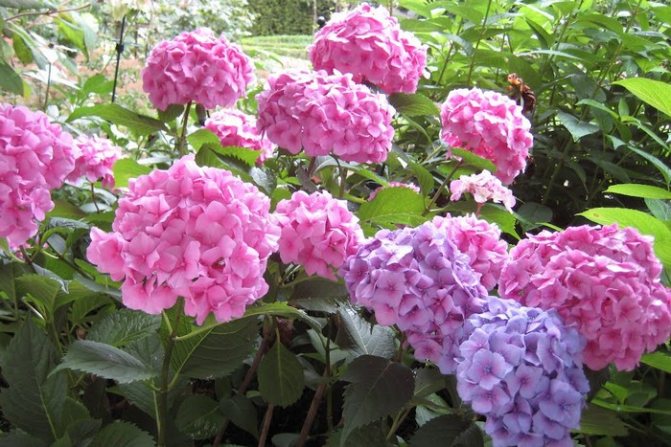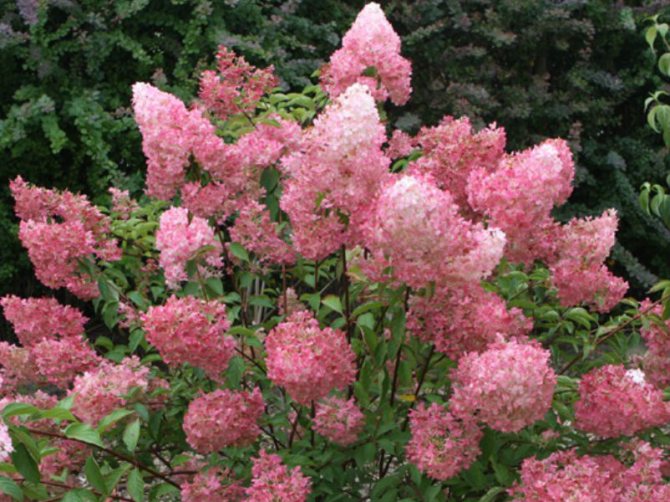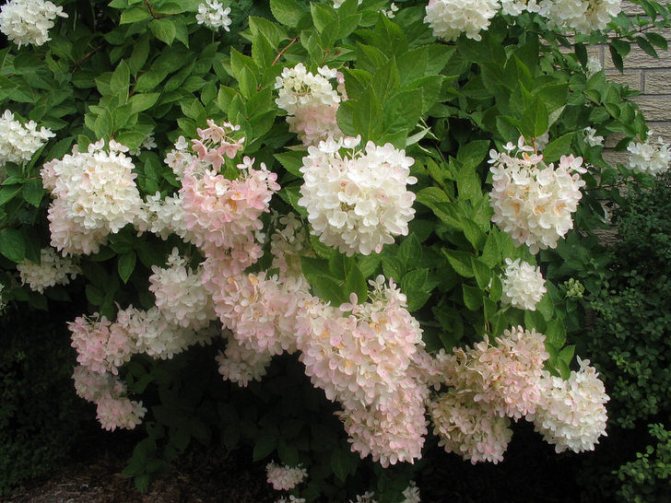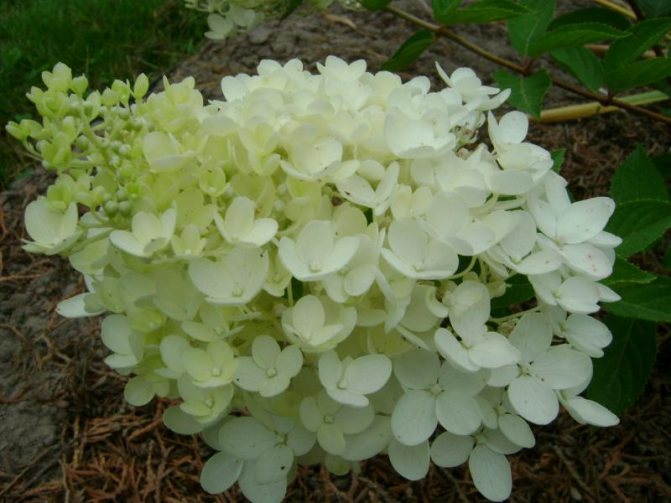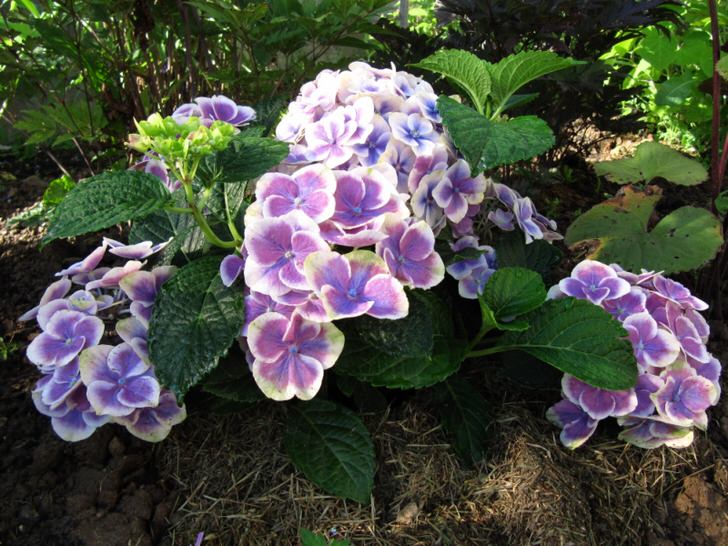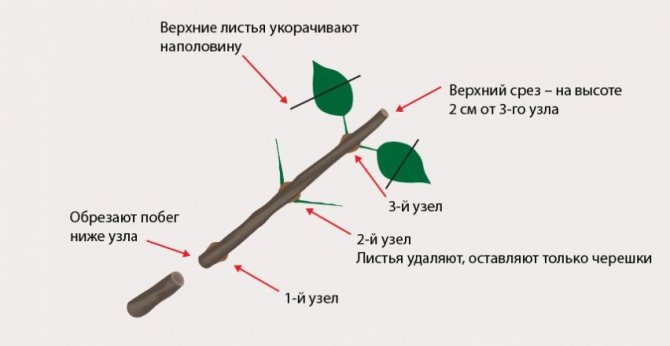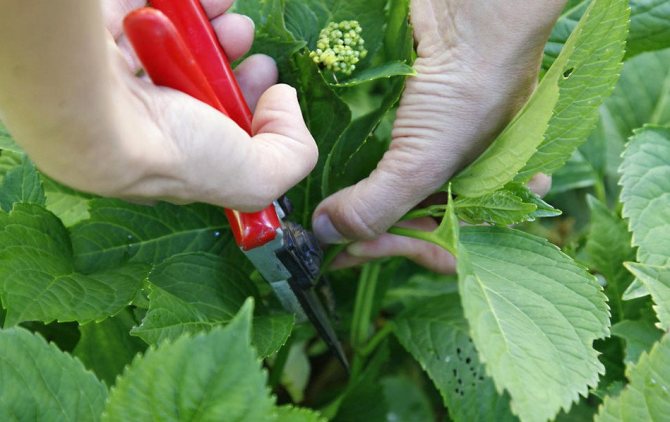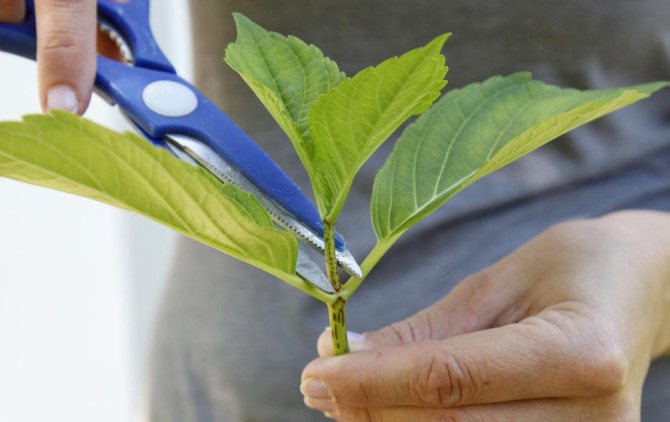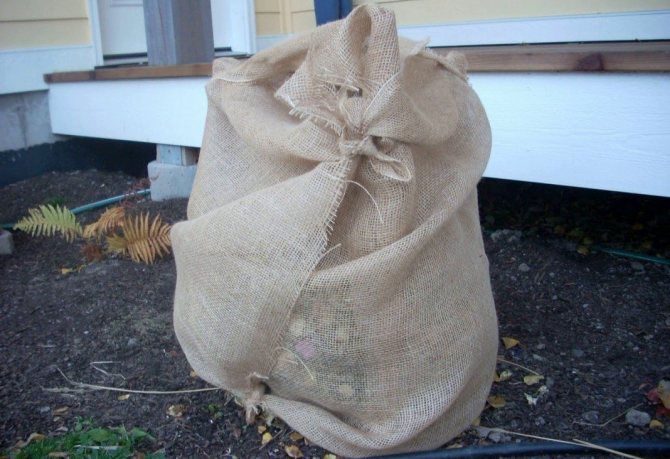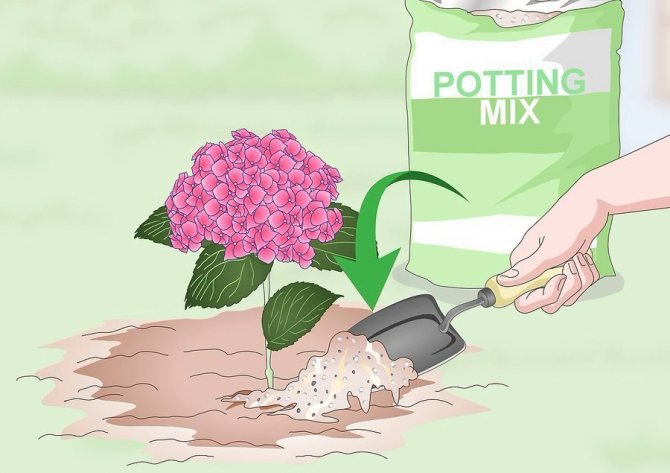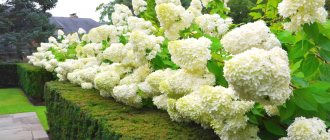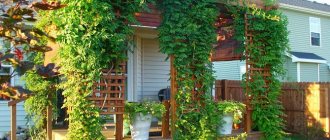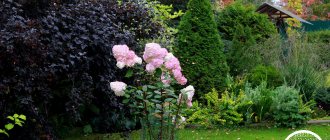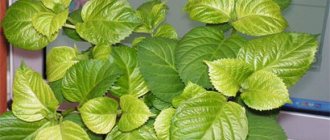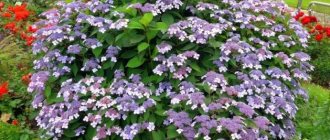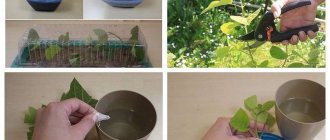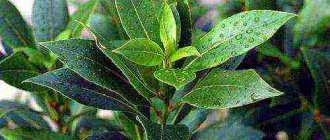Hydrangeas are deciduous shrubs that become more and more popular every year. They are increasingly found in home gardens. A characteristic feature of the shrub is beautiful and large conical inflorescences, which can be admired from summer to late autumn. Long-flowering inflorescences are most often white or have various shades of pink. There are several types of hydrangea, one of the most popular is panicle hydrangea, varieties of which with photos and names are presented in this article.
Description
The tree hydrangea (Hydrangéa arboréscens) belongs to the Hydrangea family. North America is considered the birthplace of the plant. Natural habitat - rocky mountains and river banks of Indiana, New York, Oklahoma. It is found in its natural habitat in China and India. The hydrangea was brought to Europe in the early 19th century by the German naturalist Philip Franz von Siebold. The cultivated shrub can now be seen in any country in the world.

Experts use another botanical name for the plant - hydrangea, which is translated from Greek as "a vessel with water". And this is no coincidence, since the shrub is quite hygrophilous. In Japan, the culture is called "yearning for water", in Eastern countries - "fashionista": because of the change in shades of colors (white, greenish, pink). In the language of flowers, hydrangea means "remember me." She was awarded such qualities as sincerity, hope, modesty.
In height, the deciduous shrub reaches an average of 1.5 meters, in nature - up to 3 meters. Slender tubular shoots are slightly pubescent. Bulky, ovoid leaves have a rich green color, which lasts until cold weather. In some species, shoots acquire a reddish tint by August. The length of the leaf blades is about 20 cm. Leaves on thin, long petioles are located on the branches opposite each other (opposite).
Hydrangea blooms profusely and luxuriantly from June to October. Large caps of inflorescences, reaching a diameter of 15-30 cm, consist of many flowers, which are smaller in the center than at the edges. The maximum diameter of one bud is 3 cm. Depending on the variety, the color of the petals may be different. Densely spaced inflorescences often cover the bush completely, as if a cloud had landed. By the end of October, the seeds ripen on the plant.
Treelike hydrangea is quite cold-resistant. It grows quickly: shoots grow by thirty centimeters per season.
Many legends and beliefs are associated with the plant. One of them says that on the day of Buddha's birthday a flower rain fell from the sky, and then a wonderful nectar called "amycha" poured down. Suddenly, a flowering shrub "audisai" appeared - this is how the Japanese call hydrangea.
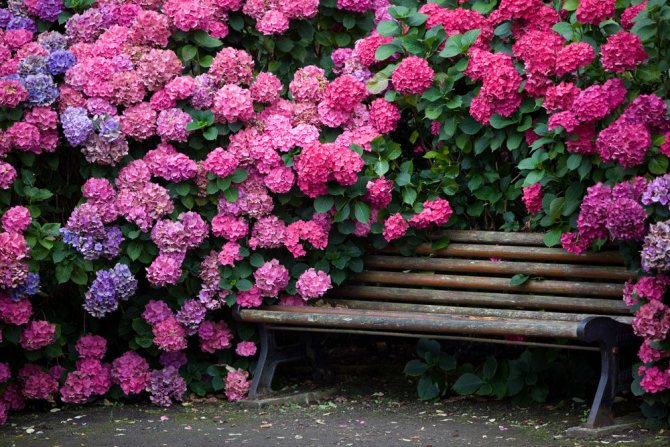

Another Japanese legend says that the guilty emperor gave his beloved family a bouquet of hydrangeas to make amends. Since then, the flower has symbolized the sincerity of feelings. Although in some countries, a donated hydrangea means love suffering and loneliness.
If we talk about signs, then an ornamental shrub growing on a garden plot will keep the owner from doing bad things, help to overcome bad habits: alcohol, smoking; will give peace of mind and well-being.
Preparation for wintering
Correctly preparing for cold weather and frost is probably the most important event. Despite the fact that tree varieties intended for cultivation in the Moscow region have good and excellent frost resistance, you should not treat them with neglect in the fall. In the first year after planting, absolutely all young bushes need to be covered in the fall, because in the first winter the plant continues to adapt to new growing conditions, the root system is not yet stable enough and can be damaged by early frosts.


Such plants must be spud with sawdust or covered with a spruce forest, closing the root collar, and even non-lignified shoots should be wrapped with agrotex or spunbond. An adult overgrown bush must be protected not only from frost, but also from winds and snow blockages, which can damage the shoots. To this end, the shoots should be tied together, a wooden or wire frame should be installed around the bush and wrapped with covering material. The main thing is to remove it in time in the spring in order to avoid damping off the root collar and the root system as a whole. In conclusion, I would like to say that 90% of the success in cultivation is the correct choice of the variety.
Focus on the conditions that you have, or that are able to provide.
Breeding is now developing very actively, so even the most modest opportunities will allow you to grow an excellent exotic plant that will amaze all your guests with its beauty, grace and charm. By correctly combining crops in the composition, protecting them from unfavorable conditions, taking care not only about aesthetics, but also about the health of the plant, you will always win, because a healthy, free-growing, flowering tree hydrangea is always better than the one that drives out flowers under stimulants and inhibitors.
Types and varieties
At the beginning of the twentieth century, the selection of tree hydrangea began. Today, breeders have bred about 70 varieties of the plant. Scientists continue to work on obtaining new unusual shades, double flowers and the original shape of the leaves. Now hydrangea has more than a hundred varieties. Winter-hardy varieties are popular, allowing you to grow an ornamental shrub in the Moscow region and Russian regions with a cold changeable climate.
Annabelle
A popular variety attracts the eye with large snow-white inflorescences, the diameter of which is about 20 cm. Under the weight of the inflorescences, branches can bend to the ground. Long bloom: June - September.


An adult shrub reaches a height of 1.5 meters, and grows up to 3 meters wide. The color of the leaves lasts until autumn. The Annabelle variety tolerates severe frosts (up to -40-50 degrees), suitable for growing in unfavorable climatic regions. Drought is more difficult for a plant to survive than cold, so hydrangea needs regular and timely watering. In one place, this garden culture can grow for 40-50 years, continuing to delight every year with magnificent "caps" of white flowers. The shade of the buds can be changed by watering the plant with a special solution.
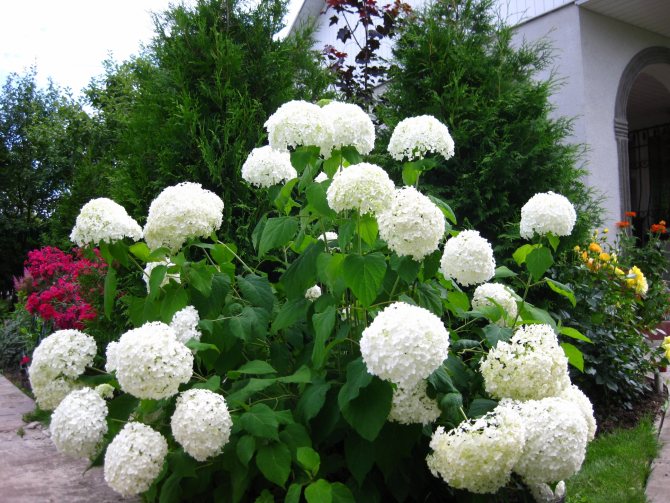

Grandiflora
It is recommended to grow hydrangeas of this variety in regions with milder climates, since the root system is not as resistant to extremely low temperatures as that of Annabelle. The plant grows rapidly, the growth of shoots reaches 25 cm per year. The size of an adult bush in height ranges from 1.5 to 2 meters, in width it grows no more than 3 meters.


Large leaves of bright green color. Umbrella inflorescences change color during flowering several times: blossoming flowers of a pale green hue acquire a snow-white color. By the end of flowering, they become creamy, with a yellow color. The flowering period is long - from June to September.


The variety is resistant to drought and pests.In rainy weather, watering should be avoided to avoid fungal infections.
Sterilis
Hydrangea is characterized by rapid growth, reaching a maximum height of about 2 m, width - 2.5 m. Flowering lasts 4 months, starting in June. The flower petals of a greenish hue acquire a snow-white color as they bloom. Heart-shaped leaves are 15 cm long. The plant is resistant to temperature extremes and needs shelter for the winter. Doesn't like to grow in windy areas.
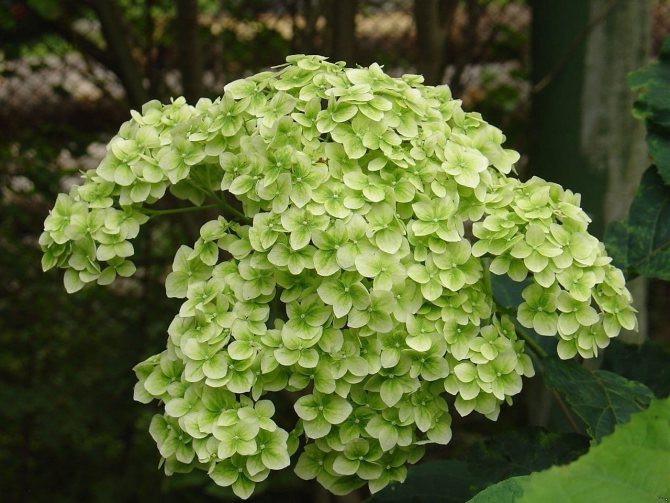

Pink Annabelle
The variety was bred on the basis of "Annabelle". The peculiarity of the tree-like shrub is the flowers of a dark pink color. Lush inflorescences are similar to a pyramid, reaching a diameter of 30 cm. Elastic shoots are resistant to strong winds and heavy rains, do not bend under the weight of flowers. Oval green leaves have a glossy shine, turn yellow and fall off in autumn.


Incrediball
This variety of hydrangea is distinguished by the large size of the inflorescences, the diameter of which reaches 30 cm. The branches of the plant are erect, powerful. They easily hold heavy inflorescences. The color of the petals changes from pale green to snow-white. The average height of an adult shrub is 1.5 meters. Bad weather is not terrible for hydrangeas: it easily tolerates drought and frost, precipitation and wind, continuing to amaze with its abundant flowering every year.


Sweet Annabel
The shrub reaches 1.2 m in height and width. Red-pink inflorescences bloom on strong shoots in June. During a long flowering, the color of the petals turns pale, by autumn it acquires a greenish tint.
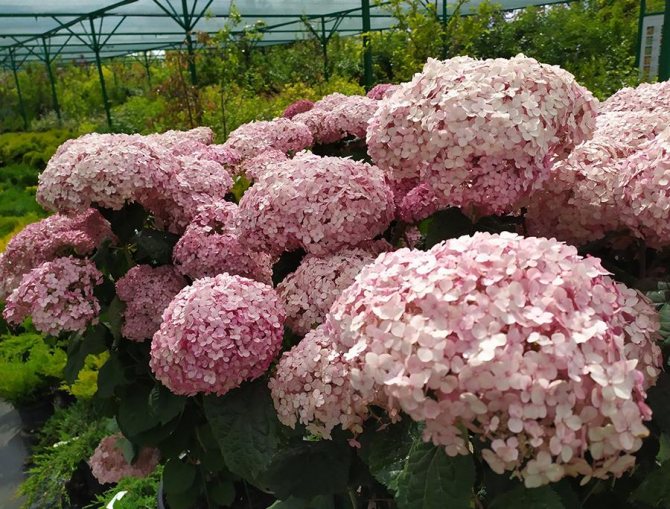

Hayes Starburst
Domed hydrangea inflorescences consist of many double white star-shaped flowers. The variety is distinguished by long flowering: from June to the very frost. The bright green leaves retain their hue until autumn. The shrub does not exceed a height of 1.2 meters. Strong branches withstand the load during flowering, do not bend.


Paniculata and large-leaved (garden) hydrangeas - differences
It happens that paniculate hydrangea varieties are confused with large-leaved ones.
There are a number of differences:
- The first difference, which is immediately visible, is the inflorescences:
- in garden hydrangeas, they are round, spherical, flattened;
- in paniculate, they have the shape of a cone, 15-20 cm long.
- The flowering period is also different:
- paniculata begins to bloom from the second half of summer and blooms until autumn;
- large-leaved blooms earlier.
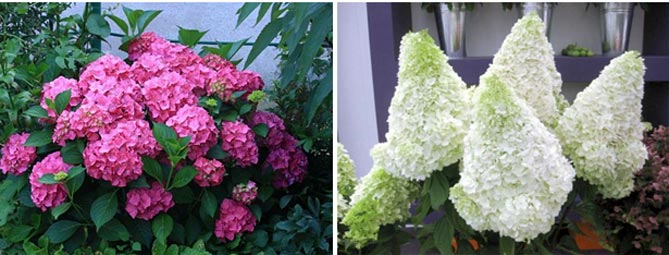

Features of growing and care
Before growing a tree hydrangea, you need to familiarize yourself with the features of caring for the plant. Observing the simple rules of agricultural technology, the ornamental shrub will annually delight with abundant flowering.
Soil selection
Hydrangea is not recommended to be planted in alkaline soil. The shrub will grow well on slightly acidic and acidic loams. A small amount of lime will not harm the plant. You can acidify the soil substrate with sawdust, peat and pine bark. This must be done 6 months before planting the crop.
Location and lighting
An ornamental shrub should be planted immediately to a permanent place, since frequent transplants are not recommended for it. Hydrangea takes a long time to adapt to a new site.


Experts advise considering the following features when choosing a place:
- abundant, diffused lighting. In this case, the scorching rays of the sun should be avoided. Otherwise, the petals of the inflorescences will lose their original color - they will "burn out", the period of hydrangea flowering will decrease by 3-5 weeks. It is also better not to plant in the shade. With a lack of sunlight, inflorescences and petals become smaller;
- protection from wind and draft. With gusts of wind, shoots with heavy inflorescences can lean to the ground, which will change the shape of the bush: it will not look so attractive;
- sufficient area for growth.The distance from neighboring bushes and trees should not be less than two meters so that they do not shade the hydrangea and do not take moisture from the soil.
Comfortably hydrangeas will grow near various garden fences. In the first half of the day, the plant will receive abundant lighting; from lunchtime, the fence will protect it from the scorching sun rays. In addition, such a place looks spectacular from the point of view of landscape design.
Temperature, humidity, watering
Proper watering of tree hydrangea is one of the important rules in caring for a shrub. With a lack of moisture, the plant can "throw off" the inflorescences, with an excess - provoke rotting of the root system.
Watering should be carried out depending on the weather: with dry - 1 or 2 times a week, with rainy - excluded for the duration of precipitation. You need to water the hydrangea with soft settled water, the temperature of which should be at least +20 degrees.


Fertilizers and feeding
It is recommended to feed hydrangea in several stages:
- the first feeding is carried out 2 weeks after planting. They are fed with the following composition: urea (20 g), potassium (30 g), superphosphate (40 g). This mixture is added annually at the beginning of spring;
- the second feeding is carried out before flowering. You can use ready-made fertilizer "Kemira-flower", or you can independently prepare a mixture of superphosphate and potassium in proportions of 50:40. Do not add much nitrogen, otherwise the flower petals will turn greenish;
- the final top dressing at the end of summer will be the introduction of rotted manure: 15 kg per 1 sq. m.
In the fall, fertilizers cannot be applied, since the branches must have time to become stiff by winter.
For the strength of the branches, you can water the shrub with a weak manganese solution.
Transfer
Hydrangea is transplanted in spring or autumn. The transplant should not be done during the summer months. During flowering, it is difficult for the plant to adapt to a new place. The inflorescences will fall off and may not appear again even the next year.
The most favorable time for transplanting is spring. It is important to carry out this procedure before bud break.
In autumn, the shrub is transplanted after flowering, preferably at the end of September. Hydrangea will have time to "get used to" in a new place before the onset of frost and winter safely.


Transplant rules:
- dig up a bush with a clod of earth, being careful not to damage the roots;
- before or after planting, the hydrangea is cut off, shortening the shoots by a third of the length;
- the transplanted hydrangea is watered abundantly;
- within 2-3 weeks after transplantation, the shrub must be shaded from the bright rays of the sun;
- feeding is carried out in a month, when the active growth of shoots begins. This means that the hydrangea has successfully rooted.
Winter preparation and winter care
Varietal hydrangea has good winter hardiness, which allows it to be grown in regions with a harsh climate. Even if the plant is damaged by frost, it grows back and blooms.
Faded inflorescences and new shoots must be removed in autumn: young shoots may not tolerate frost. Experienced gardeners, wanting to grow a short bush, often cut off all branches, leaving 2-3 buds on each. New shoots appear in the spring. Hydrangea thus rejuvenates.
Annual and biennial plants need shelter for the winter. Covering material or spruce branches will save the hydrangea from frost. You can build a wooden fence around the bush to trap the snow.
For the winter, it is advisable to sprinkle an adult shrub well, sprinkle the soil around the leaf with yellowed foliage to protect the roots from frost.
Soil for hydrangeas
Hydrangea is considered one of the most unpretentious garden shrubs, however, only if it is planted on the soil appropriate for its needs: nutritious, with a sufficient amount of humus, containing many draining particles, well filled with moisture.
If you have an uncultivated piece of land, in a hole dug for planting you need to prepare a mixture of earth, consisting of 2 parts of humus, 2 parts of leafy soil, one part of peat and sand.
If vegetables grew in the same place, under which manure was applied, the humus part must be reduced. Hydrangea does not like dense clay soils - they are moisture-absorbing, but they dry out for a long time and are poorly supplied with oxygen, such soil must be diluted with peat. Sandy soil is poor in humus content, and it also needs to be enriched with humus and peat.
You can not plant hydrangeas on alkalized soils, with an acidity of pH higher than 6.0, the optimum pH is about 5.0.
Pruning in spring
Pruning hydrangea trees in spring is done before bud break.


The procedure has three objectives:
- rejuvenating: branches are left no higher than half a meter from the ground. Such a plant will bloom only next year;
- shaping: to give a decorative look to the shrub. So that the plant does not thicken, and the flowering is abundant, strong shoots are shortened by 3-5 buds, weak ones are reduced by 2 buds. After this type of pruning, the hydrangea must be fed with nitrogen, potassium and phosphorus;
- sanitary: broken, dried, undeveloped shoots are removed after winter.
Young tree hydrangea is not pruned until the age of four.
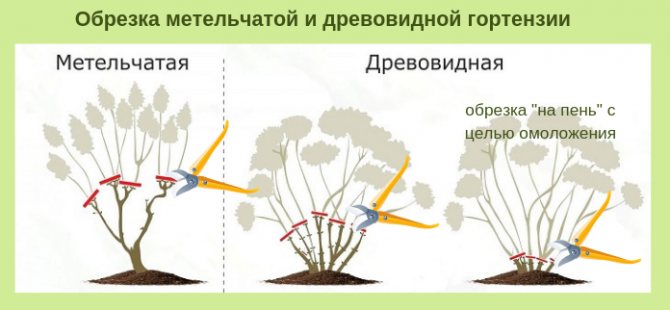

Watering
Watering plays an important role in the active and healthy development of tree hydrangea. Hydrangeas can tolerate short-term drought, but lack of moisture immediately affects their appearance:
- leaves lose turgor;
- droop and turn pale;
- inflorescences may die off ahead of time.
Therefore, it will be advisable to carefully monitor the water balance.
An adult plant needs a weekly watering of 20 liters for each bush, which is best done in the evening or early morning. Top dressing with mineral fertilizers is carried out from the end of May to the end of August, every two weeks with complex mineral fertilizers, or superphosphate or potassium sulfate, in the dosage indicated in the instructions for the fertilizer. If the summer is hot, you can mulch the trunk circle, which will reduce the loss of moisture and prevent overheating of the soil.
Reproduction methods
Hydrangea can be propagated in three ways.
Green cuttings
Cuttings are cut in early June with 2-3 pairs of leaves. Half of the leaf plate is cut off. Shoots are placed in slices for 5 minutes in a root growth stimulator. Cuttings are planted in a greenhouse or on a bed with light nutritious soil. Shade. The lower paired buds are deepened into the ground to the middle of the internode.
After 20-30 days, the cuttings will take root. During this entire period, it is necessary to maintain high humidity by covering the cutting with a cut plastic bottle.


Layers
In the spring, the shoot is carefully bent to the soil, laid in a shallow groove, sprinkled with a layer of soil substrate 2 cm thick, pinned. The top of the shoot does not need to be sprinkled; bend it up a little.
The soil must be kept moist throughout the season. In summer and autumn, the soil needs to be poured. The following spring, the rooted shoot is separated from the adult bush with pruning shears. It is planted in fertile soil in a shaded area for growing.
A tree hydrangea grown from cuttings or cuttings can be planted in a permanent location after a year or two. A young shrub will bloom in the 4th year.


By dividing the bush
The hydrangea is dug up and divided using a pruner or a sharp shovel. New parts of the plant are planted in a hole, which is prepared in advance. Then the branches are cut. The divided hydrangea takes root well.
Planting hydrangeas
It is best to plant hydrangeas in the spring when the threat of recurrent frosts has passed. In the southern regions of Russia, it can be planted in the fall.
When planning a place for planting hydrangeas, it is necessary to take into account the size of an adult bush, leaving a distance of about 1 meter between plantings.
The size of the dug hole is about 50-60 cm wide and deep.Fill it 20-30 cm with soil, then put a 5 liter bucket inside (empty) and fill it around with earth. Compact the soil. Now take out the bucket - you will have a neat hole 25-30 cm in diameter and wide and deep. Place a hydrangea bush or a rooted stalk in it, without deepening the root collar. Sprinkle the roots with earth, not compaction too much. Water.
In 3-5 days, the earth will settle, after which we mulch with peat.
Possible problems
Hydrangea wilted: the plant lacks moisture. This can also happen due to the excessively high air temperature.
The leaves turned yellow: old leaf plates turn yellow due to waterlogging, young ones due to excessively hard irrigation water. Water it with moderately soft water, depending on the weather.
The color of the inflorescences has changed: this means that the acidity of the soil has changed.
The flowers have burnt out: one of the reasons is that the hydrangea is constantly in direct sunlight. The shrub should be shaded at noon.
Slow growth, poor flowering: wrong growing site. The plant is in the shade all day long, lacks sunlight.


Location
In the southern regions of Russia, choose a place that is bright, but protected from the scorching afternoon sun (partial shade). From the eastern, northwestern part of the site of the gazebo, the wall of a house or a barn.
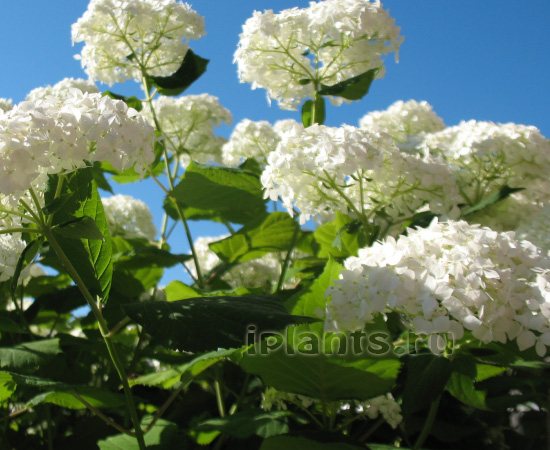

In the central regions of Russia and the northern regions, choose a place that is drier and more open, warmed by the sun, but keep in mind that hydrangeas do not like prolonged exposure to direct sunlight (southern and southwestern side). Try not to plant hydrangea next to other plants with water loaves or large shrubs and trees - there is competition for moisture, the plants will have to be watered often.
Diseases and pests
Proper care is the key to hydrangea health. High humidity and low temperatures can cause fungal infections that affect leaves and flowers. Such diseases include powdery mildew, septoria, rust, downy mildew, gray and white rot. For preventive purposes, it is recommended to treat tree hydrangea with Bordeaux liquid. A diseased plant is treated with specialized fungicidal agents.
Sometimes hydrangea is affected by insect pests: aphids, slugs, spider mites, nematodes. With a slight defeat, you can try to destroy the parasites with the help of folk remedies. To do this, prepare a garlic or tobacco solution (100 g per 5 liters of water), infuse it for 2 days. Before spraying, add a small amount of soap to the solution so that the infusion adheres well to the leaves.
In case of significant damage, you will have to use the appropriate insecticides - "Aktellik", "Aktara", "Fitoverm" and others.


Application in landscape design
Hydrangea is considered one of the most versatile ornamental crops in modern landscape design. The oak-leaved species looks quite organic both as a monoculture and in group plantings.
Most often, bushes are used for landscaping the lower tier of tree-like vegetation, creating hedges or decorating areas near all kinds of garden buildings. Bushes are also successfully grown on artificial or natural slopes.
The most successful partners in planting hydrangeas are:
Check out
Hydrangea on a trunk in landscape design
- lily;
- peonies;
- low varieties of roses;
- stonecrop;
- asters;
- lilac;
- derain;
- spirea;
- rhododendron;
- weigela;
- heather;
- cypress;
- barberry;
- mahonia.
How to arrange hydrangeas with each other
For planting hydrangeas, a hole is dug, measuring 40x60 cm. Its depth varies from 35 to 70 cm, depending on the size of the seedling. To get a free hedge, you need to dig up a meter strip.
The distance between adult specimens should be 1.5-2.5 meters... To get a flower "bouquet" early, the pits are marked every 0.7-1 meter, and after a few years the group is thinned out.
Knowing about the features of each species and variety, you can choose the most optimal option for your garden. And then the luxurious hydrangea will surprise you with the splendor of the foliage and the bright riot of caps-inflorescences!
In the article, you learned what types and varieties of hydrangeas are suitable for growing in Russian gardens. You can find out about caring for hydrangeas in the garden here.
Ornamental shrub hydrangea Bretschneider
According to its habitus, the ornamental shrub of Bretschneider's hydrangea, found in 1882 in the vicinity of Beijing, rather resembles a lilac or a large chubushnik. Its height is up to 4 m. It can grow in the form of a bush or tree, it is very frost-resistant, durable, does not bother with shoots, does not require any props. Compared to other hydrangeas, it is drought-resistant. This miracle blooms annually and very abundantly, covered with slightly fragrant inflorescences with a diameter of about 15 cm.
As you can see in the photo, the Bretschneider hydrangea flowers are milky white at first, later painted in pink and purple tones:
The color of the inflorescences can change when the acidity of the soil changes. In this type of hydrangea, the flowers are collected in large umbellate, slightly convex shields that stay on the plant for a long time, until late autumn.
Fruits - dry capsules - ripen in September. Blooms from 5-6 years.
The Bretschneider hydrangea (N. bretschneideri) propagates by seeds and cuttings.
Cuttings usually root without problems. The root system of the hydrangea is superficial and branched. Hydrangea can grow in partial shade and in the sun. Moreover, in full sun it blooms better, but there it needs to be watered, otherwise the leaves can dry out and burn.
Dislikes calcareous soils and windy places. Does not tolerate winter dampness, the soil must be sufficiently permeable.
The shrub is cut off before sap flow begins. Strong faded shoots are shortened to a well-developed node with buds, all old, weak and frozen ones are cut out. The hydrangea is fed with special fertilizers for hydrangeas, rich in magnesium and iron.
Bretschneider's hydrangea is a unique plant. This is a magnificent background in a shrub mixborder, which makes up an element in a shrub group that you want to see blooming in the second half of summer.
Look at the photo - this type of hydrangea looks great in autumn and winter in combination with viburnum, hawthorn, Köne's mountain ash (with white fruits):
With these plants, hydrangea also looks interesting in summer thanks to the contrasting foliage.
For a long time, Bretschneider's hydrangea was impossible to buy. Now domestic nurseries have begun to grow it.
Bretschneider hydrangea varieties are sometimes found in Western European nurseries:
'Snowcap'
‘Jermyn’s Lace’
The diameter of their inflorescences is gigantic - from 25 to 30 cm. How the varieties will feel in central Russia is unknown.
Changing the color of flowers
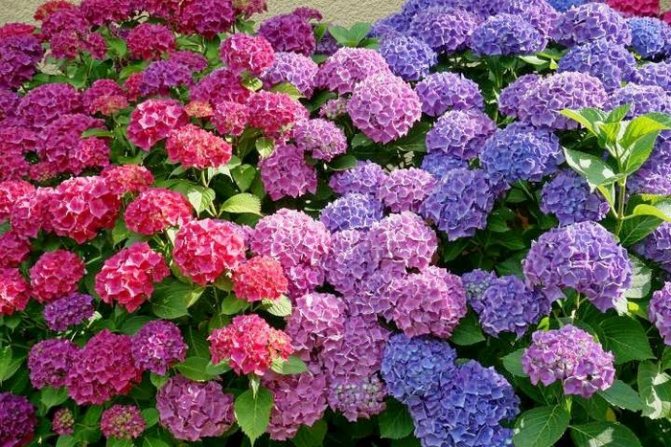

The color change of hydrangea flowers depends not only on the variety, the content of aluminum and iron in the soil and pH. The acidity of the soil determines the ability of plants to obtain minerals. Acidic soils color the inflorescences blue (aluminum), alkaline soils pink (aluminum is not available). To reduce the acidity of the soil by raising the pH (color change from blue to pink), lime is added to the soil in the spring. To increase the acidity of the soil (changes in flowers from pink to blue), add aluminum sulfate in the spring or acidic mulch (from oak leaves or pine bark). Some varieties, regardless of soil pH, change color, the petals become greener, bluer or colored, giving interesting effects. There are special preparations available for watering hydrangeas.
Hydrangea in the original design of the site
We will not shy away from such a variety of shrubs as petiolate hydrangea.This species resembles a liana, reaching a length of up to 25 meters. This variety can be chosen for decorating gazebos or facades, decorating recreation areas. The plant winds along a support, in its absence it will behave like a ground cover crop. Hydrangea leaves are smooth, flowers are fragrant, light, collected in shields.
Oak-leaved hydrangea is distinguished by carved foliage, which in other varieties has an oval or rounded shape. Shrubs grow up to 2 meters, the crown is lush. Young plants do not react well to frost, therefore such varieties of hydrangea are relevant for Russian gardens in the southern regions. An additional decoration of the bush in September is the leaves, which acquire a red tint.
Summer residents and lovers of original plants living in the south of Russia can afford to grow ashy, serrate, radiant varieties of shrubs, Sargent's hydrangea with bright thyroid inflorescences.
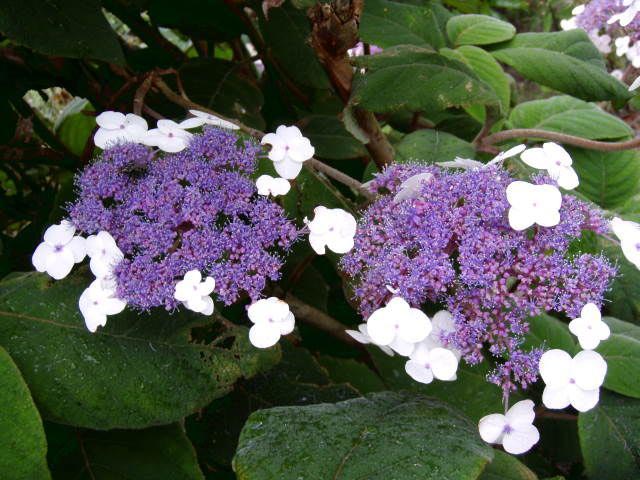

Choosing the right variety is a crucial step on which the success of growing hydrangeas depends. This is a flower that requires a fraction of your attention, but the correct arrangement of the shrub and unobtrusive care in 2-3 years will give fruits in the form of a beautiful plant with lush inflorescences.
Now the main thing is to plant!


Hydrangea planting and care
Any plant requires certain parameters for planting. Hydrangea also requires.
back to menu ↑
See also: Schefflera home - unpretentious exotic: description, types, cultivation, care, reproduction, transplantation (60 Photos & Videos) + Reviews
Secrets of agricultural technology
Hydrangeas have almost the same requirements for growing conditions. When growing hydrangeas, emphasis is placed on:
- Watering: Plants love moist soil. Regular watering prevents the soil from drying out. An adult shrub is watered twice in a drought, spending up to 40 liters, 20 liters are enough for a young specimen. Large-leaved hydrangea suffers most from over-dried soil.
- Mulching. To maintain soil moisture, the soil under the bush is mulched:
- sawdust;
- humus;
- straw;
- coniferous butcher.
Important! Rotting mulch increases the acidity of the soil and improves its structure.
- The growth and development of hydrangea determines the type of soil, preferably loam with a pH of 6-7. Avoid adding manure to the soil and adding lime to the planting hole.
- A sunlit or shady flower bed, as well as drafts, are not quite suitable for a hydrangea planting site. Partial shade to the liking of the bushes. The most light-loving culture is the panicle hydrangea.
- Shrubs are pruned in early spring or at the end of winter, starting at 4 years of age. In the bush, up to 12 strong shoots are left, which are shortened by 30-40 cm. Cut branches are suitable for cuttings. The operation improves the immune system of the panicle hydrangea, causes the development of branches and the splendor of the shrub.
- Hydrangea blooms luxuriously if mineral feed is added twice a month, organic matter - 1 time.
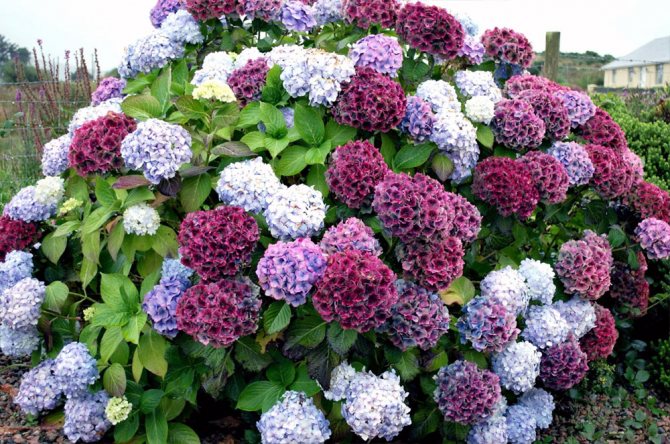

Hydrangea blooms
Feeding crops begins in the spring and ends in the height of the summer season:
- before adding mulch, a complex fertilizer is used, Kemira flower is in demand, it is sprinkled around the bush;
- in the bud stage, they are fed with phosphorus and potassium 50 g each and potassium sulfate (25 g);
- beware of frequent nitrogen application - it affects the shade of flowers, hydrangea does not cope well with wintering;
- feeding plants with whey or kefir with soaked bread is suitable.
Pest and phyto-disease control
If spider mites and aphids are bothering you, use insecticides:
- Kleschevit and Tiofos;
- Aktara and Fufanon.
In case of chlorosis, iron-containing preparations are added during irrigation.
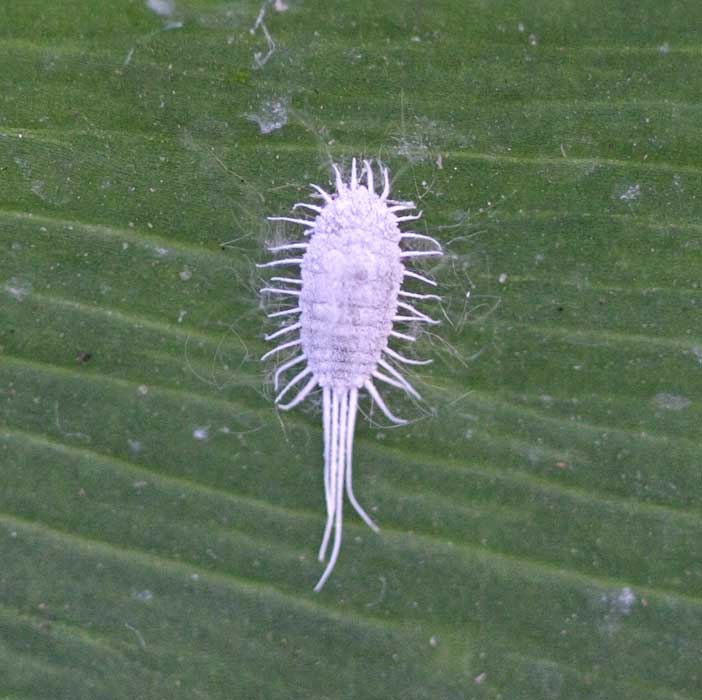

Kleschevit and Tiofos
How to survive the winter without losses
However, despite the assurances of breeders and sellers in the cold resistance of plants, the bush needs to be covered with the onset of winter.
In order for the hydrangea to winter well, it is important:
- Spud shrubs before the approach of frost, pour a couple of buckets of soil into the root zone of the hydrangea.
- Place low wooden boxes near the bush.
- Place the shoots of the plant on the boxes and attach to the soil through the holes in the boxes.
- Wrap the hydrangeas with non-woven material several times, on top with plastic wrap.
- Reinforce the shelter with bricks or stones from gusts of wind.
The variety of hydrangeas will allow gardeners to make a worthy choice. Which varieties to choose and how to plant is a matter of personal taste.
How to prune bushes
In order for the plant to have a beautiful shape, be strong and bloom magnificently, it is proposed to prune excess shoots and branches once a year. Gardeners recommend pruning old, weak branches without affecting the main stems. Flowers appear on new shoots of the second year, so it is better not to touch young shoots. It is not necessary to remove many shoots at the same time, as the plant may weaken. When choosing the time for a haircut, preference is given to the autumn season. Sometimes this is done in early spring, in this case, flowering may begin later. In the spring, pruning should be done before the buds appear.
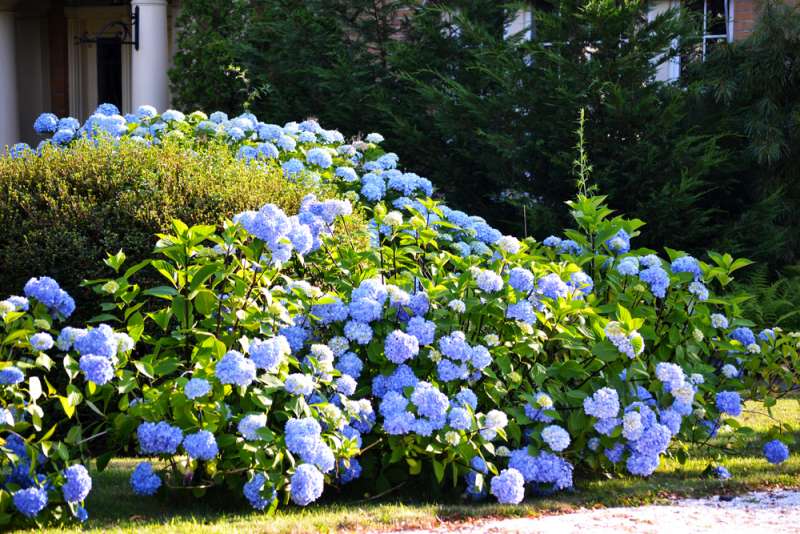

Oak-leaved beauty
Unlike the previous paniculata, the oakleaf hydrangea is not so well-known and common in our gardens. However, the places where it is grown, with the arrival of autumn, are decorated with crimson foliage and have a very effective decorative appearance (Figure 3).
Oak-leaved hydrangea can become a decoration of any garden for all seasons. Starting from summer and ending in late autumn, it pleases its owners with chic inflorescences with a fragrant pleasant aroma, to which bees, butterflies and other insects fly with pleasure. The flowers are usually white in color, their inflorescence is cone-shaped.
Hydrangea should be planted in shady places or in partial shade, this will not affect the flowering of the plant. As for the soil, it is better to use moisture-permeable mixtures. It will not be superfluous to feed the soil by adding fertilizers.
Like the previous types of plants, oak-leaved hydrangea care requires completely uncomplicated care: it is enough to observe the necessary soil moisture for this moisture-loving plant, preventing the earth from drying out.
Pruning of oakleaf hydrangea is carried out in spring or autumn. Dead and damaged shoots are removed, making it possible for new ones to appear faster.
Oak-leaved hydrangea, like many other species of this shrub, is highly resistant to cold weather. However, in the first year of life for the winter, it is better to transplant it into a pot and take care of it like a houseplant.


Large flowers of oak-leaved hydrangea. White edging looks delicate and graceful.


The lush hydrangea bush fits perfectly into the landscape design.
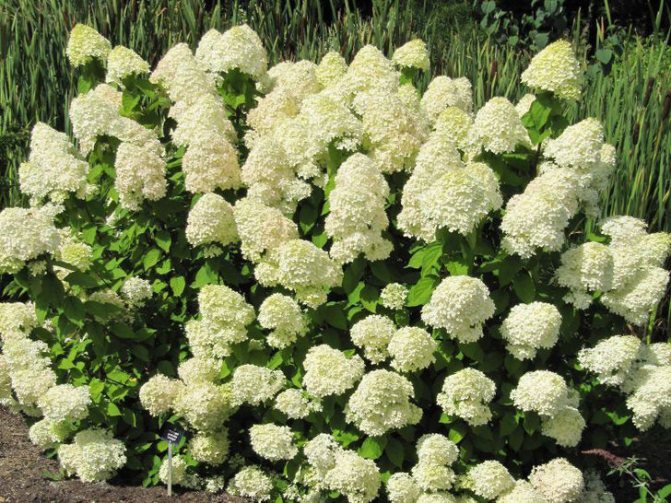

An example of a properly groomed hydrangea bush.
Hydrangea paniculata varieties Sundae Fraise (Sunday Fraise)
Hydrangea of the "Sundae Fraise" variety grows up to 1.5 m in height. Its width usually does not exceed 1-1.20 m. Due to its small size, the bush is successfully planted in containers. In mid-June, it blooms with conical inflorescences, at first white, and closer to autumn - purple-red. Coloring occurs gradually: starting from the bottom, the pink tone slowly makes its way to the top. Hydrangea variety "Sundae Fraise" was awarded a silver medal at the 2010 Holland Flower Show.
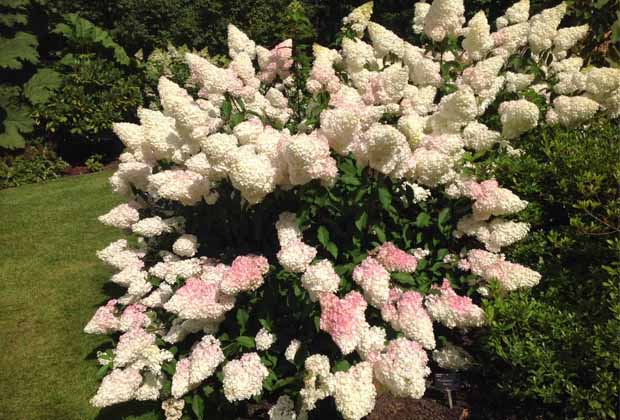

Hydrangea petiolate, or creeping
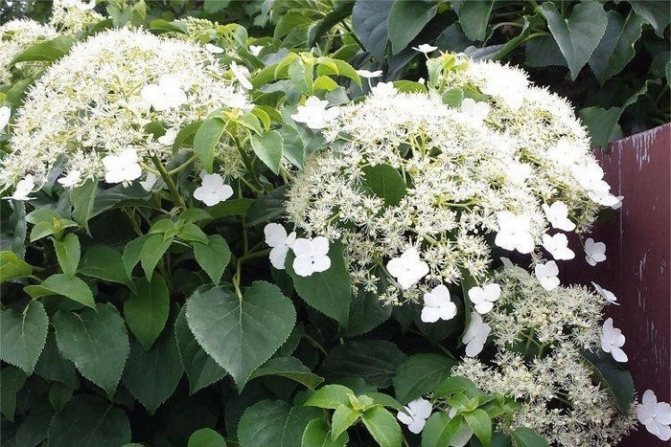

Stalked hydrangea is a lush species, a lignified liana growing 9-25 meters high, climbing trees and walls with the help of adventitious roots. "Lacy" flowers appear in summer. They have the shape of flat brushes with a diameter of 15-25 cm. The flowers are slightly fragrant, often used for bouquets. The species is becoming popular in gardens due to its abundant flowering. It is planted in the garden as a groundcover in the shade. Leaves are dark green, ovate, pointed at the end, yellow in autumn. Providing good soil and water conditions, it grows luxuriantly, needs massive supports.
Popular varieties names: Cascade.

